REPRINTED WITH PERMISSION FROM THE CHRISTIAN SCIENCE MONITOR
Volunteers have worked for decades in Sudbury, Ontario, to restore the land in the once-polluted mining town. They say their work holds lessons for breaking the endless cycle of conflict between industry and environmentalists.
SEPTEMBER 24, 2020 - GREATER SUDBURY, ONTARIO - When the Superstack was constructed in 1972, it was the tallest structure in Canada – and the tallest smokestack in the world. At 1,250 feet, it’s visible from every vantage point in the area. It can be seen from the bustling streets of downtown to the quiet cul-de-sacs of residential neighborhoods. It looms large in the distance from highways that feed into a city that is home to one of the largest mining complexes in the world.
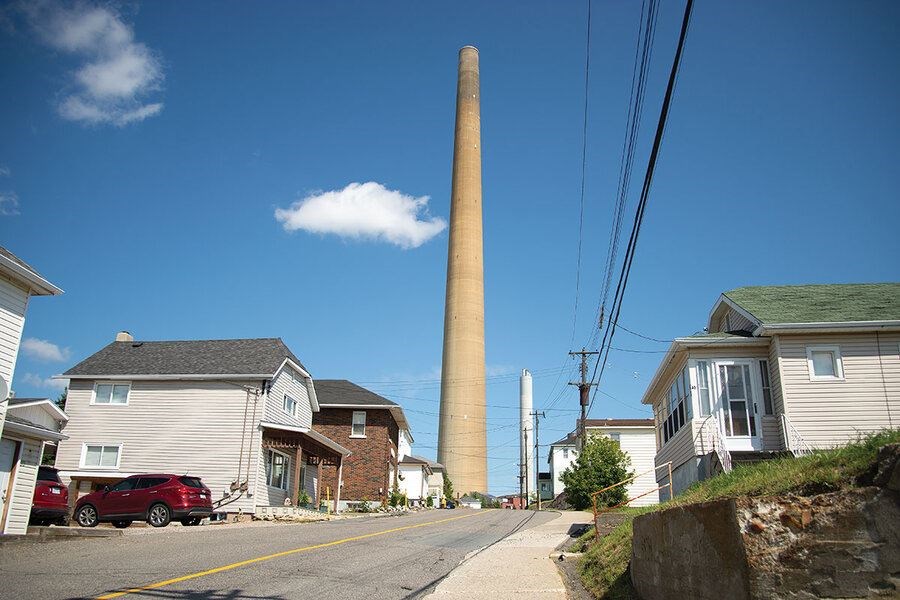 Houses line a street in Sudbury, Ontario, where they can see the Superstack, a symbol of the city’s gritty past that is being replaced with two smaller stacks.Laura Cluthé
Houses line a street in Sudbury, Ontario, where they can see the Superstack, a symbol of the city’s gritty past that is being replaced with two smaller stacks.Laura Cluthé
Built by Canadian company Inco before it was purchased by Vale, the Superstack has long stood as a reminder of the environmental devastation that mining wrought here. But this year the chimney is being fully decommissioned.
Residents of Sudbury harbor mixed feelings about the Superstack. Some see it as a memorial to their rise as a center of nickel and copper mining globally. Others see it simply as a familiar landmark that signals they are home. Gisele Lavigne lives in the Copper Cliff neighborhood at the Superstack’s base. She spends her evenings looking at the towering structure from her yard, and likes it when the stack disappears behind a heavy fog. “And when it rains, you’ll see half a stack, depending on which way the wind blows,” says her partner, John Leach, who works in the mining industry doing sand and high-pressure water blasting.
Others see the Superstack as a relic of an era of polluting that doesn’t fit with the current ethos of Sudbury. One leading scientist here, John Gunn, believes the concrete shell should be “blown up.”
Whether or not the structure remains a fixture on the skyline when it’s taken out of operation, it tells a powerful tale of renewal. The stack was built as part of an industrial complex that denuded the land here of any kind of vegetation, leaving blackened rocks and lakes without fish. The landscape drew comparisons to moonscapes and barren Martian worlds. At one time the smelters in Sudbury were the largest point source of sulfur dioxide in the world.
It got so bad that scientists, politicians, industry officials, and the community finally came together to halt the pollution, replant the trees, and restock the lakes. It has been 40 years of toil and triumph, and the story is not over yet. But today Sudbury enjoys some of the cleanest air quality in Ontario. Residents swim and fish in the 330 lakes inside the city’s boundaries. And those here say the community of 165,000, at the gateway of northern Ontario, offers a lesson in how to break the cycle of conflict that the current climate crisis often creates, pitting industry against the environment.
“That’s what we need to take from the Sudbury story, and we need to apply it to today,” says David Pearson, an earth scientist and driving force in turning around Sudbury.
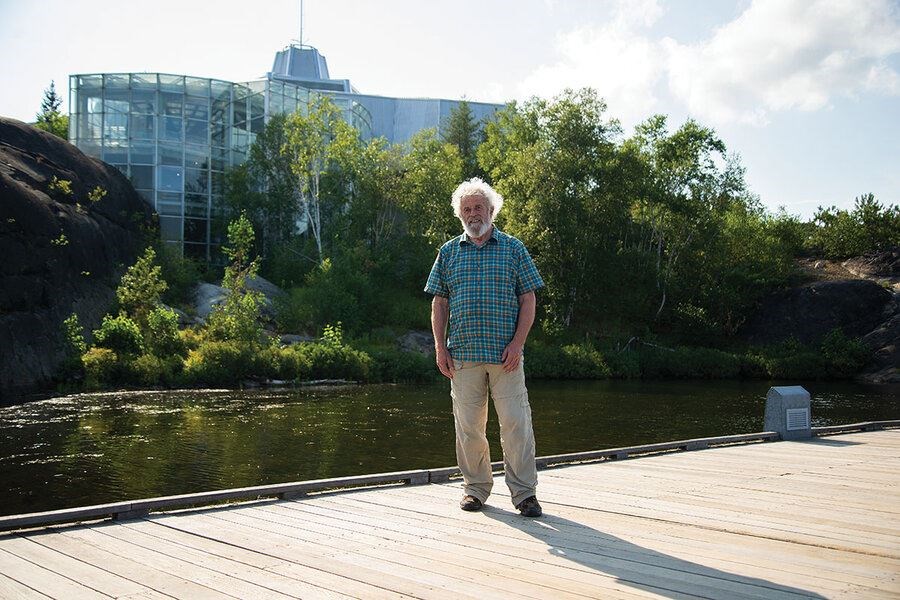 “When one speaks of the Sudbury story, it somehow seems local and isolated, and it’s not local and isolated. It’s an example of what we need to modify in order to be able to live alongside a thriving environment.” – David Pearson, an earth scientist who has been instrumental in the city’s green revivalLaura Cluthé
“When one speaks of the Sudbury story, it somehow seems local and isolated, and it’s not local and isolated. It’s an example of what we need to modify in order to be able to live alongside a thriving environment.” – David Pearson, an earth scientist who has been instrumental in the city’s green revivalLaura Cluthé
“When one speaks of the Sudbury story,” he says, “it somehow seems local and isolated, and it’s not local and isolated. It’s an example of what we need to modify in order to be able to live alongside a thriving environment.”
***
This area was once called Ste. Anne of the Pines for the old-growth forest that flourished here. Later, after the logging industry moved in, lumber harvested from the prized trees was shipped far and wide – including to Chicago to help rebuild after the Great Fire of 1871.
Environmental devastation accelerated after the 1880s when metal deposits were found along a crater formed by a prehistoric meteorite impact. The deposits, discovered during the construction of the Canadian Pacific Railway, represented one of the largest concentrations of sulfide ore in the world. The metals forged in huge foundries here were used to build armaments during both world wars. Early methods of roasting the ore polluted the landscape locally, while later smelting techniques expanded the damage regionally. Dr. Pearson, who arrived from a coal mining town in northern England, remembers distinctly how bad the air smelled one day in 1969. “It was perhaps humid, and [the plume] came down to ground level,” he says. “And I parked in the parking lot, and I had to run in order to be able to hold my breath long enough to get into a building because the smell of the sulfur dioxide was so powerful even in my car. ... I had never experienced anything nearly as penetrating a pollution as this.”
For a child in Sudbury back then, fun didn’t involve climbing trees or playing hide-and-seek in the forest. Young people like Dave Courtemanche, who went on to become mayor, clambered over rocks. There was no greenery to be found in his neighborhood or at his school, which directly faced the mining slags. One day in 1975, a university professor came to Dave’s fifth grade class to propose an experiment: Let’s see if we can get grass to sprout in the barren landscape.
On a hillside, he and classmates carved out an acre of land and limed and fertilized it. As tufts of grass began to poke through, he recalls a feeling that might be comparable to children of the tropics seeing their first snowflakes. “Looking up and seeing a green patch emerging from the dead earth was nothing short of a miracle,” he says from that old school building today, which looks out onto woods and grassy fields. Mr. Courtemanche was unwittingly among the first volunteers in one of the largest regreening efforts in Canadian history.
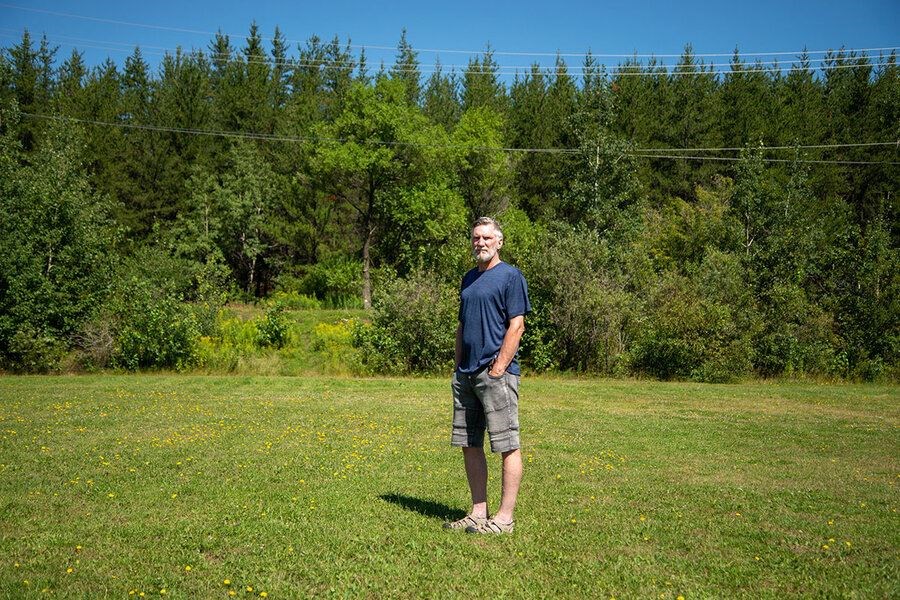 “Looking up and seeing a green patch emerging from the dead earth was nothing short of a miracle.” – Dave Courtemanche, recalling how he and his fifth grade classmates, in 1975, got grass to grow in a barren part of the Sudbury landscape as a school experiment.Laura Cluthé
“Looking up and seeing a green patch emerging from the dead earth was nothing short of a miracle.” – Dave Courtemanche, recalling how he and his fifth grade classmates, in 1975, got grass to grow in a barren part of the Sudbury landscape as a school experiment.Laura Cluthé
Throughout the first half of the 20th century, Sudbury was a company town. At its peak, 20,000 miners worked underground – the ebbs and flows of the city defined by worker shifts. No one dared speak out against the industry.
But then Laurentian University was established in 1960. “Nobody was going to say anything against the company, essentially,” says Peter Beckett, an ecologist at the university and chair of the city’s advisory panel on regreening. “And so the university was kind of the first independent thing in the town, and people started asking questions: ‘Can one do anything about the landscape?’”
As it turns out, they could. Biologists at both the university and at Inco had been experimenting with regreening, first potting plants and then moving to plots outside. By 1975, the “Sudbury recipe” was created – the basis for a massive liming project that would neutralize the soil and allow for replanting.
The effort coincided with a downturn in the nickel industry and worries on the part of local politicians that the town wasn’t going to survive unless it reinvented itself. Regreening became a communitywide endeavor. Unemployed miners and student volunteers alike wielded lime sacks and scattered seed. Dr. Beckett remembers the first year in 1978, when the community landscapers would scour their Garden of Eden for the first shoots. “After the Aug. 15 [heavy rains] that first year, every member of the committee was out every day looking constantly at the same area to see if any green fuzz was coming up,” he says. “And then one day, about a week later, everybody just shouted, ‘eureka,’ just like the Greeks.”
On a hillside overlooking Kelly Lake, Dr. Beckett and Graeme Spiers, another scientist from Laurentian University, show how the landscape would have looked if no replanting had taken place. They point to a sickly birch tree surrounded by a few mounds of metal-tolerant hair grass.
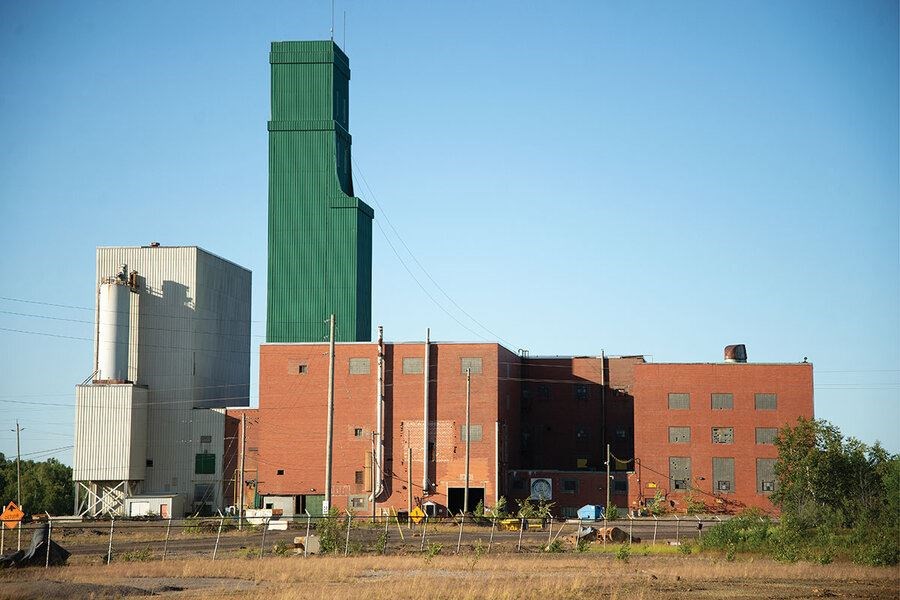 The old Creighton nickel mine, which was closed in the 1980s, houses an underground research facility where scientists study neutrinos.Laura Cluthé
The old Creighton nickel mine, which was closed in the 1980s, houses an underground research facility where scientists study neutrinos.Laura Cluthé
Nearby stands a lush forest. It’s one of the replanted parcels. Overall, locals have created a forest of about 10 million trees and shrubs. Since 2010 they have focused on replanting native species, about 80 different types, and they are working on measuring carbon capture that will help the city meet its goals to be carbon neutral by 2050. After 40 years and $33.5 million (Canadian; U.S.$25.4 million), they are about halfway through the recovery of 200,000 acres of land.
Yet the effort is about more than fixing a lost landscape. “If you improve the environment, you attract people and suddenly your community starts feeling better about itself,” says Dr. Spiers.
The two have traveled the world delivering that message – to Australia and South Africa, Peru and Poland, Chile and China. Their roadshow is called “Sudbury, 40+ Years of Healing.”
None of this would have been possible without tough regulations, though. When the Superstack was built, mining’s motto for the era was “Dilution is the solution to pollution.” New technology and evolving processes helped reduce emissions in Greater Sudbury, but the Superstack dispersed them further afield, to neighboring provinces, and as far as the United States and Greenland. It essentially turned a local problem into an international one.
Sudbury’s reputation was already suffering. In 1971 and 1972, NASA sent astronauts to the city ahead of the Apollo moon missions to study the geology of the crater basin. It was the second-largest impact crater in the world, and they wanted to prepare for similar sites they might see on the moon.
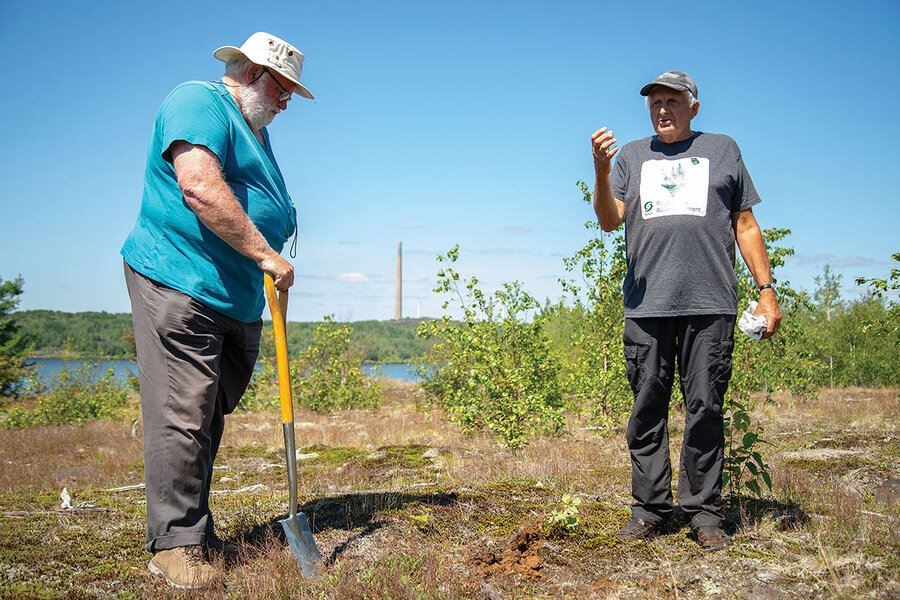 “If you improve the environment, you attract people and suddenly your community starts feeling better about itself.” – Graeme Spiers, a scientist from Laurentian University in Sudbury (left) with Peter Beckett, a Laurentian ecologistLaura Cluthé
“If you improve the environment, you attract people and suddenly your community starts feeling better about itself.” – Graeme Spiers, a scientist from Laurentian University in Sudbury (left) with Peter Beckett, a Laurentian ecologistLaura Cluthé
But instead of lauding Sudbury as a lunar training ground, the press came up with another moniker for the city: a moonscape. The city’s image took a severe hit.
It didn’t help that emissions from the Sudbury smelters had affected an estimated 7,000 lakes in the region. Declining populations of lake trout, which thrive in Canada’s cold, clear northern waters, became a symbol of the environmental degradation, similar to what the polar bear is today for a warming Arctic.
Dr. Gunn, director of the Vale Living With Lakes Centre in Sudbury, recalls attending his first international science conference in Ithaca, New York, in 1980 and learning that his peers were using the name Sudbury as a unit of pollution – “How many ‘Sudburys’ does your country represent?” He says he has since devoted his entire career to make the term Sudbury known as a “unit of restoration.”
Sudbury’s pollution even sullied relations between the U.S. and Canada, as acid rain emerged as a significant environmental issue. “I traveled to Washington, New York City, and a couple of other places in the United States and tried to persuade them to cut their emissions. And when I would go down to lecture them on their problems, the first word that would come out was Inco,” says Jim Bradley, who was Ontario’s environmental minister at the time and grew up in Sudbury. “Inco was the largest single emitter of sulfur dioxide in North America at the time.”
So the provincial government developed the Countdown Acid Rain program, which forced Inco and other major polluters in 1985 to cut emissions by more than 60% in under a decade. The companies balked at first. But Mr. Bradley remembers the exact moment he knew they had changed.
“Three years later, they came down to Toronto and had a press conference, with the word Inco in green,” he says. “And there they announced that they would not only be complying with the regulation that we were forcing on them, but that they would be exceeding the provisions of it and that they would be making a profit of 19% on one aspect of it and 6% on another aspect.”
Part of the shift was driven by the changing politics of the environment. The Superstack had become a rallying point for activists in both North America and Europe. “The [company] didn’t want a dirty reputation,” says Dr. Gunn. “Senior executives admitted that their kids gave them [trouble] at home.”
Today, Dr. Gunn stands at the edge of Silver Lake, which he once documented in a book as being one of the most acid- and metal-contaminated bodies of water in the world. Kids are jumping off rocks. A dog paddles furiously in the water.
The whole cleanup, local organizers say, is a testament to how the community came together. “There’s no question, of course there was finger-pointing, but it was not the dominant mood at the time,” says Dr. Pearson, the earth scientist. “You have to remember that the city was very defensive, very self-conscious. ... So when there were glimmers of an opportunity to repair the landscape and improve the image of the community, people got together without pointing fingers. It was a ‘let’s get on with this’ kind of attitude.”
Everyone, young and old, got involved. “It was such a powerful experience for our children because now they were part of the solution,” says Mr. Courtemanche. “I would argue that you can’t be part of the solution until you see yourself as part of the problem. So we were all part of the problem here. We let the landscape perpetuate the way it was until folks realized they could come together and effect phenomenal change.”
That, he believes, is a lesson urgently needed today. “This idea that you have to take sides, that these types of major issues are political and polarizing, I think is fundamentally wrong. People just need to show up and say, ‘I’m going to be part of the solution.’ And quite frankly, I think the world needs more Sudburys if we’re going to tackle some of these major issues facing society, whether we’re talking about climate change or COVID.”
***
Sudbury is still very much a mining town. There are 7 to 11 mines operating at any given time, says Jennifer Beaudry, the senior manager at Dynamic Earth, a mining museum. It’s just that mining looks very different than it once did.
The Superstack is part of that evolution. The mining company Vale finished the final steps to take it out of service in July, replacing the towering structure with two smaller stacks that require far less energy to operate and will reduce greenhouse gas emissions at the smelter by approximately 40%. The move is symbolic of how technology is advancing, and the city has become a research hub for new mining techniques.
“It’s not shovels and pickaxes [anymore],” says Ms. Beaudry.
The narrative is not unblemished, though. Some locals think the mining companies, for all the profits they dug out of the ground here, should have done more – earlier – to help both workers and the town.
Yet the overwhelming feeling seems to be one of pride in the city’s restoration. In 2015, Canada’s statistics agency polled urbanites nationwide and found Sudbury’s residents to be the happiest in the country. Tourists no longer come to see the slurry in the city’s big smelters run like hot lava. Instead they head to Dynamic Earth to go on an underground tour, or visit Science North, the city’s renowned science museum. More students are flocking here, too.
“No, this is not a mining town, at least not anymore,” says Vinay Balineni, a student from India who is working on a business degree.
Pride in the city’s new environmental ethos is even reflected in local art. Muralists paint building facades with scenes that celebrate natural resources. “There’s been not just transformation of the environment but transformation of the mentality of why it’s important to create opportunities for environmental consciousness and conservation,” says Johanna Westby, a muralist and graphic designer whose works depict lakes, trees, water, and birds.
Perhaps more important for the future, a new generation of environmental activists is taking root in Sudbury. Jane Walker, Maggie Fu, and Sophia Mathur epitomize the trend. The three teens, who just started eighth grade, recently participated in virtual climate training with former U.S. Vice President Al Gore.
Sophia is often called Canada’s first climate striker, joining Swedish teen activist Greta Thunberg and youths around the world in skipping classes every Friday to demonstrate on behalf of the environment. She is also the lead plaintiff in a lawsuit against the Ontario provincial government for weakening its climate targets. The 13-year-old infuses her words with passion, eloquently talking about the intersection of social and climate justice.
“I think Sudbury’s regreening showed everyone [here], and the world, that with our community working together, we can make a difference,” she says.
It’s a story of inspiration the three teens hold close to them while they carry out their strikes, which they do virtually these days because of the pandemic. Says Jane: “If we can do all this [transformation] in the community, well, then we can do anything to try and help our environment.”
Page created on 9/24/2020 9:30:57 PM
Last edited 9/24/2020 9:48:42 PM
